Waterproof bathroom fixtures
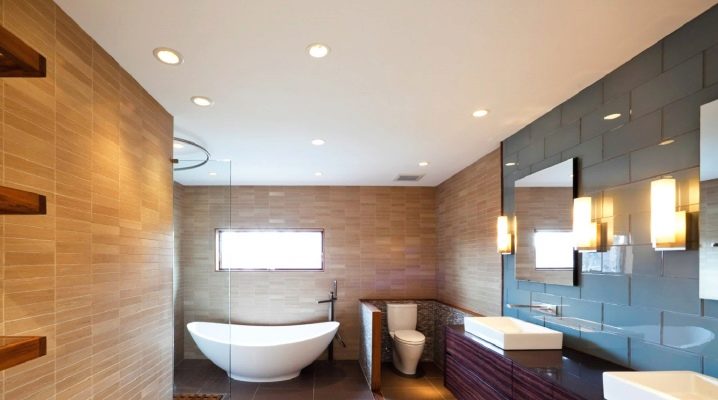
Lighting in the bathroom, the main place for hygiene and relaxation in the home, can be very varied and interesting, but its organization requires a thoughtful and attentive approach. There are many design ways, this market segment is very rich in interesting solutions - what are the only lamps that can be completely submerged in water. The main thing when choosing is the result, namely, the ability to easily take a shower or bath.
Such a room should be well and evenly lit, but the light should be made soft, and in some cases even dim. This can be achieved in different ways: waterproof bathroom fixtures are very suitable.
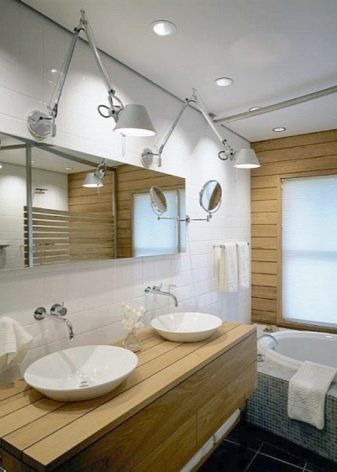
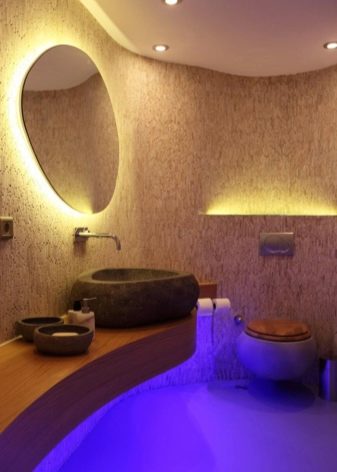
Features and structure of moisture-resistant lamps
It may seem that shower lighting fixtures look almost the same as ordinary ones. But this is only a superficial impression. The main differences lie in the design of the light sources. Most often, there are closed products, but inside such lamps there are many additional protective elements.
These include various insulators, rubber seals and other parts that prevent moisture and dust from entering the product structure.
Often, heat-resistant materials are also used in the manufacture of such lamps, because a bathroom is not only a room with high (and very unstable) humidity, but also a place of constant temperature changes. The parts of the luminaires are quite fragile, and the metal parts are prone to corrosion. Protecting them is essential. Otherwise, they can not only wear out quickly, but also lead to more serious problems - damage to the wiring, and even to a fire.


A feature of waterproof luminaires is their closeness. The shape of such devices is usually sharpened to be splash and dust resistant. There are also anti-shock mechanisms that make the case more durable. The latter point is especially relevant, since in the bathroom the lamps are often located on the walls, at the same level as the hands. With any careless movement, they can be broken.
When choosing a luminaire for a home "sauna", you should pay attention to its tightness and articulation of parts, as well as to the strength of the body.

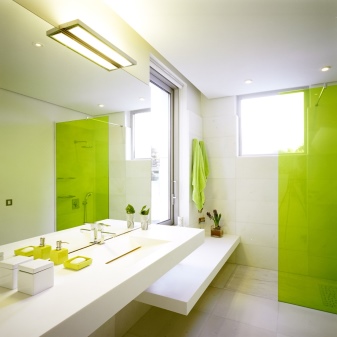
It is these factors that are the features of waterproof luminaires that ensure the safety of use and the durability of products.
And one moment. The bathroom is often a room with no natural light. In most apartments this is exactly the case, so the bathroom lamp for some will become the only source of light (at least with the door closed). As a result, there is no need to think about the relationship and harmony of natural and artificial light spaces. In some ways, this is an advantage for interesting design solutions.
Lighting in a bathroom can be created from scratch ”, so choosing a bathroom lamp is a particularly responsible business.

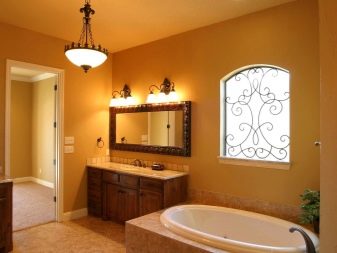
Varieties
There are many classifications of bathroom fixtures. These or those manufacturers often focus on certain properties of products.
Luminaires can be dust and moisture resistant, heat resistant, moisture resistant, waterproof.Special moisture-proof (water-proof), dust-moisture-proof, shockproof mechanisms can be built into them.
Lighting fixtures can be either completely sealed or with open parts, portable or static.
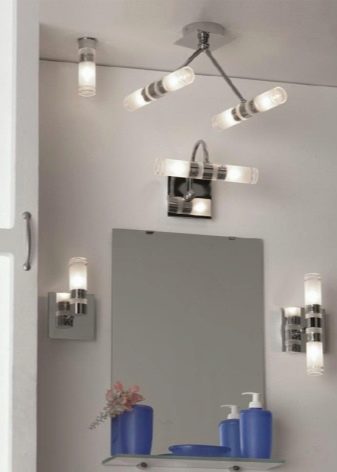
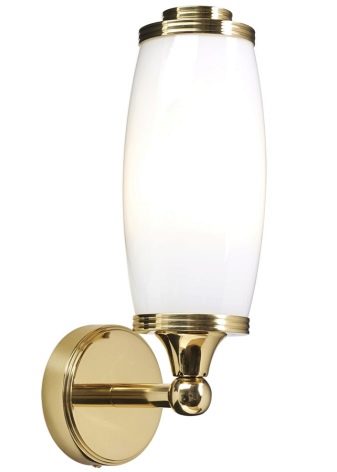
By the type of lamps - LED (diode), fluorescent, neon and so on. There are both point models and sources of diffused light (through false ceilings).
Shapes and designs can vary - some designers, for example, style floor lamps to look like ice, creating "warm ice" cubes. Others experiment with rounded surfaces.
Another classification is the division of products according to the degree of protection against various negative environments and contacts - moisture, dust, physical damage.
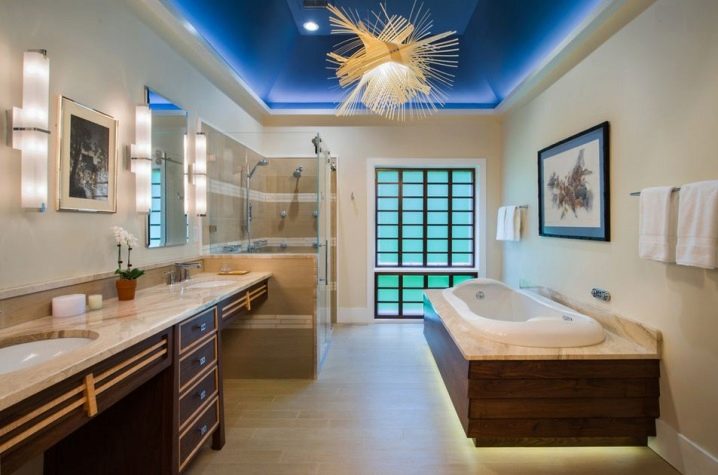
By appointment
When buying bathroom fixtures, you should immediately decide where they will be mounted. In such rooms there are several zones, for each of which its own type of device is suitable:
For shower cabin
Of course, it is better not to install the lamps directly in the shower room, but if it is nevertheless necessary for some reason, you should choose the most moisture-resistant models. The shower is a place of contrasts, both in humidity and temperature. In addition, it is in the shower cabin that the lamps can inadvertently be touched by hand or foot. It is unlikely that fluorescent lamps or incandescent lamps are suitable here.
The best option for a shower is spot lighting, possibly with LEDs.
But it is desirable to make the light soft, although not necessarily warm at all - cold shades will also create a suitable mood and will harmonize pleasantly with water.
Often on the market you can find shower cabins with built-in lighting. If it is wired, you will have to take care of the quality of the electrical wiring in the bathroom as a whole.
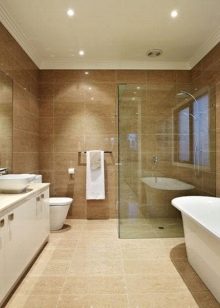
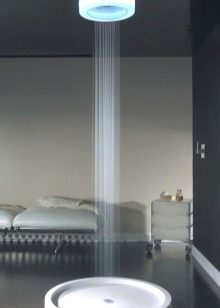
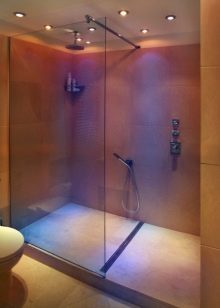
For bathroom
- Entrance. Here the choice is widest. You can take almost any lamp, it is better - sealed, but not always as closed as possible - especially if the room is large. It is worth paying attention to the heat resistance of the product. He will also have to withstand high humidity.
The light temperature can be any, but for small rooms it is better to give preference to a warm range.
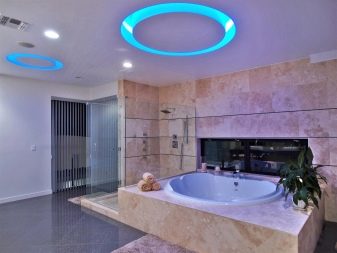
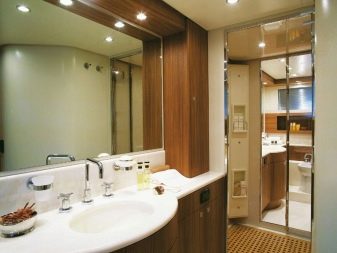
- Main zone. Here, the waterproof properties of the device should be higher. It is better to place it aside from the shower stall, so that accidental splashes do not fall on the lamp when leaving it. The light temperature is selected depending on the style of the room, design. Cold light lamps are suitable for high-tech interiors, and warm notes for baths decorated with floral arrangements.
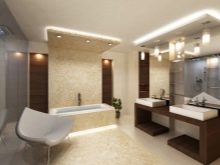
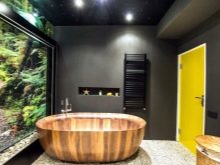
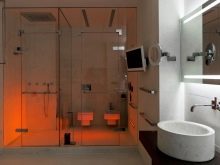
In the design of the bathroom itself
Only waterproof models are suitable for bathing. Note that the light will refract and diffuse. Cold lamps are used more often.
For a room with high ceilings, all the noted recommendations are also relevant - the microclimate is formed in the room as a whole. Spotlights and LEDs are suitable for such rooms.
If a staircase or a straight corridor leads to the bathroom, it is advisable to combine the two interiors with a single light palette. It will be possible to turn on the light everywhere, but it is better to install the "entrance" lamp in the corridor - it will not suffer from high humidity and temperature, but will give approximately the same effect as if the device was placed directly in the bathroom.
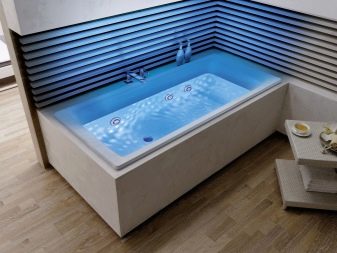

By placement method
The range of bathroom fixtures, of course, is only a small segment of the lamp market, but the selection is quite large. It is worth leaving "out of brackets" the option with a conventional incandescent lamp located on the ceiling or above the front door. An interesting, but not very suitable idea with a large chandelier in the middle of the room should be ruled out.
Then, conventionally, all lamps in this category can be divided into five groups
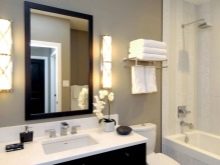

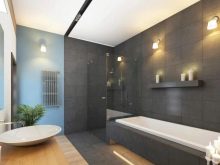
Ceiling
The classic version is a technological continuation of the solution with the aforementioned incandescent lamp. The advantage of such products is that they can give the room an additional design chic and color, and also make the light soft, uniform - and variable.
With the help of such lamps, you can divide the bathroom into several light zones - a washbasin, a shower room and others. Among the disadvantages is the need to maximize the moisture-protective properties of lighting devices, because it is the ceiling products that are subject to all the risks inherent in the room. The steam, together with the high temperature, constantly rises to them.
Such luminaires must be sealed, moisture resistant and heat resistant.
With high ceilings, these devices are protected from accidental water ingress - in the form of splashes.

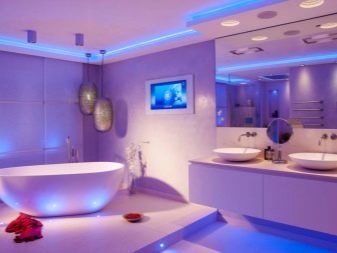
Floor standing
A rather rare option, but it is gradually becoming very popular. This radical bathroom solution requires a very meticulous approach in terms of safety. However, the dust and moisture-proof, heat-resistant body of such products may well provide it. There are very interesting portable options on sale - this is one of the unique advantages of such products.
There are models stylized as ice ("blocks of ice"), with geometric and sculptural outlines, and other options. In some cases, the light sources are mounted directly into the floor.

As a rule, floor lamps are used in large rooms, quite often in country houses or cottages. Only a large space allows them to fully reveal their potential, which makes the room brighter.
The use of such lamps in small bathrooms is fraught with the appearance of various glare, brightness, which will be annoying, and "weighting".
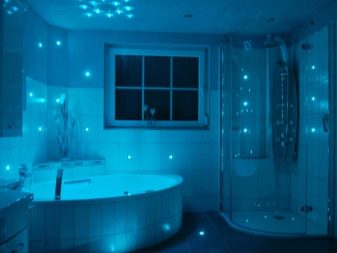
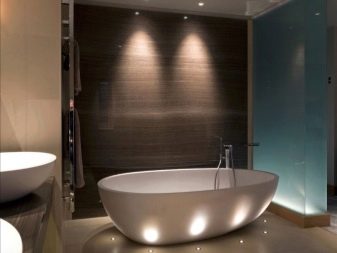
Wall mounted
Often these are fluorescent lamps, well-protected products from dust and moisture. They can be diode, point. Wall lights must also be protected from physical damage and have good shockproof properties, as they are frequently touched by accident, especially in small showers.
Such devices provide quite a sufficient amount of light, however (due to the specifics of their location) they can interfere with the creation of maximum comfort, it is unpleasant to discord in the interior with batteries, hangers and other necessary elements of the room. It should also be added that the waterproof properties of wall lamps are sometimes noticeably inferior to the properties of other types of products - due to their design and location. And the spray from the shower often falls on the walls, not the ceiling.

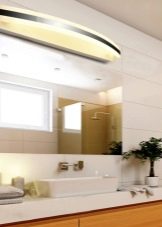
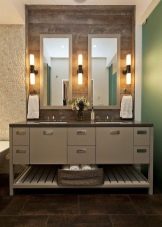
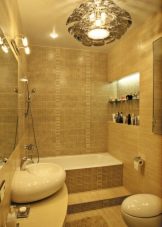
It is better to use such lighting devices away from the shower and sink (as an option, near the front door). These lamps will look more advantageous in large rooms, but in this respect their use is not so categorical. Even in a small bathroom (if you choose a suitable place for such a lighting fixture), you can simultaneously solve several problems at once - to achieve bright, uniform lighting.
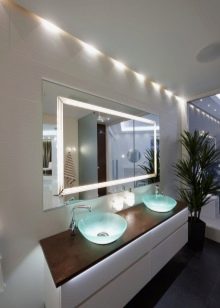
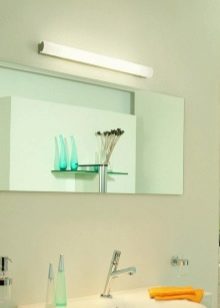
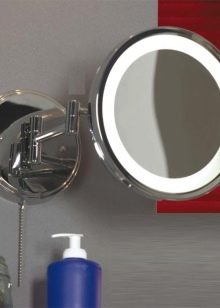
Mortise and built-in
They are used, for example, in false ceilings. The built-in luminaires themselves may not have increased waterproof properties, but they still need heat resistance.
Most often, mortise luminaires built into other structures belong to the category of powerful LED products that allow you to bring light through artificial obstacles. As a result, the main disadvantage of such lamps is the inability to actively control the light. Alternatively, the use of a dimmer (electronic dimmer) or other technological solutions, this will allow you to control the brightness of the lighting.
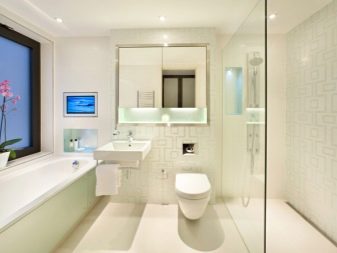
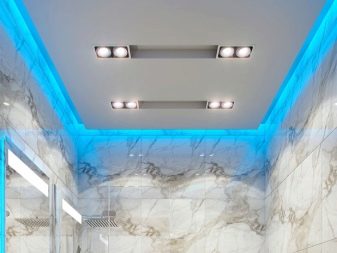
Underwater
In ordinary bathrooms, such devices are rarely used, more often they can be seen in swimming pools. If you have a large bathroom, it can be an interesting design find.They must be waterproof and have very good shockproof properties.

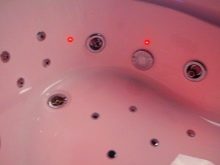

Degree of protection
One of the main points that you should pay attention to when choosing a product is the degree of its protection from various external factors. Lighting technologies have now advanced quite far, so that you can find products on sale that are practically unaffected by household loads.
The protection of a luminaire from certain factors is a measurable and fairly clear indicator. It is called IP (Index of Protection).
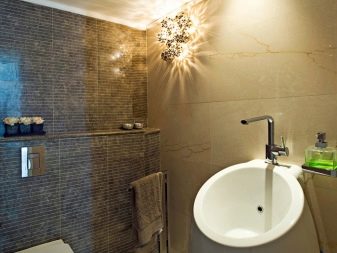
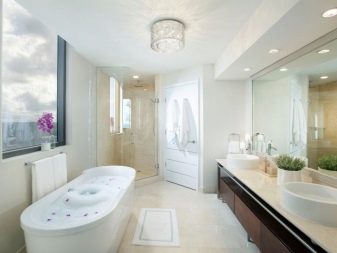
The key ones in it are the first two digits, indicating the degree of protection against dust (ingress of solid particles) and moisture resistance.
The first digit can range from 0 to 6 in order of increasing dust protection. 0 - it does not exist at all. With a unit, the product can be touched. Such a device is not yet protected even from insects. Further, the indicators are 12 mm, 2.5 mm and 1 mm. The number 5 indicates high dust protection, and at 6, practically nothing will get into the device at all.
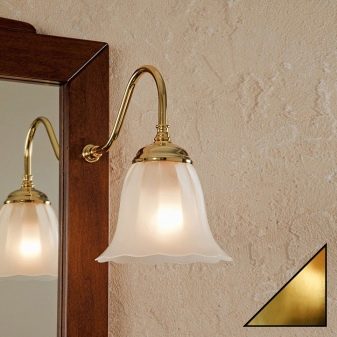
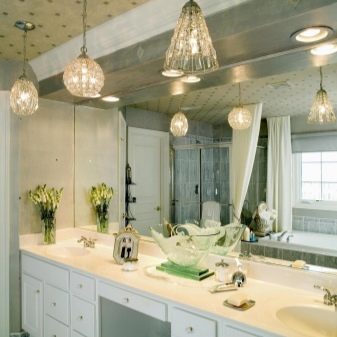
In terms of moisture resistance, the range usually includes numbers from 0 to 8.
- 0 is the absence of any moisture protection.
- 1 - ensures operability when vertical drops hit.
- 2 - the quality of the luminaire is maintained when moisture gets in at an angle of 15 degrees.
- 3 - already at 60 degrees (conditional rain).
- 4 - a fairly universal option (splashes can fall on such a lamp from any side).
- 5 - even jets of water will not harm such a device.
- 6 - you can work with sea salt.
- 7 - will not break if immersed to a depth of one meter. Suitable for fixtures that are installed directly into the bath.
- 8 - the luminaire can be used for a long time and practically at any depth possible in domestic conditions.

Luminaires with different security indicators are suitable for different baths, but the key point is to divide the bath into zones. Let's consider the classic version. Directly in the bath and at a distance of no more than 10 cm from it, the IP must be at least 67 (for convenience, it is worth combining the numbers into a number). At a distance of about half a meter - 44. Further, it is possible to use even lamps with IP 21.
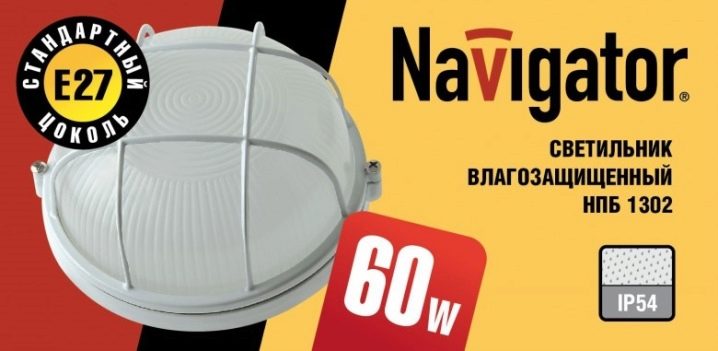
Often in IP, you can also find the third digit, which indicates the impact resistance of the product. This indicator is graded according to the same logic as the previous ones. This is not the main, but also an important criterion when choosing a product. However, even strong parts (such as metals in the bath) can suffer from corrosion. This means that the impact resistance in such conditions in some cases may decrease over time.
The main thing is that water and dust do not get inside the lamp, as well as that it does not break - otherwise the first two points will not matter. Whatever the IP, it is better to handle the products with care, try to avoid moisture, especially splashes.
A good way to increase the longevity of your fixtures is to regularly ventilate the bath. Always leave the door open after a shower.

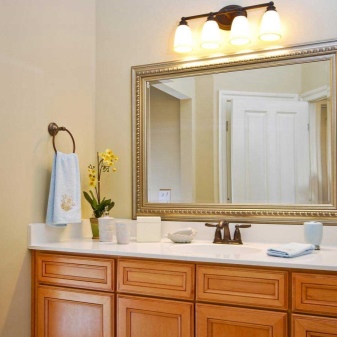
There is one more curious detail worth noting. Moisture resistant fixtures designed specifically for bathtubs tend to be more durable than other similar products. They can be effectively used in other premises as well. In climates with high humidity and an abundance of insects, such products are especially useful and relevant.
Optional accessories
The quality of electrical wiring in the bathroom is vitally important in the truest sense of the word, so when organizing lighting, you should pay special attention to the wires. Better if they are in the walls. The fewer wires are in open spaces, the safer the room, especially in the case of inevitable contact with water.
If in the bedroom or living room unsuccessful "communication" with a closed cable is limited to just a feeling of discomfort, then in the bathroom this can lead to serious injuries, or even death.
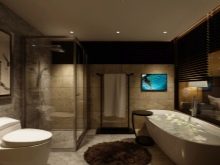

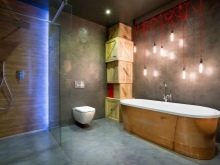
The first and foremost advice is to entrust the installation of cables to specialist electricians and do not skimp either on the quality of materials or on the quality of work. If after such work somewhere there is a wire, something is clearly wrong. In bathrooms, only hidden electrical wiring is possible - according to official rules. And no wires, especially in "sleeves" and metal sheaths. Even sockets in the bathroom must have a specific specification - usually IP44 - and a special cover.
In addition, in the bathroom, special mechanisms are usually used to protect against possible interruptions and short-circuits - grounding, alignment, and so on. This is especially important if the bathroom uses various appliances that receive energy from electricity, for example, washing machines.
With a careless attitude to this issue, even in the simplest situation (for example, when connecting a hair dryer), a short circuit may occur.
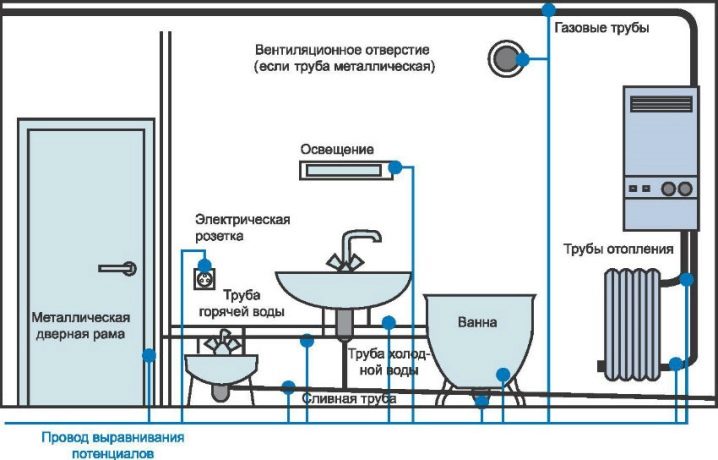
A separate point is the switch. It must also be dustproof and waterproof. It must be very securely attached to the wall, otherwise all its advantages will lose their meaning. It is also better not to save money here, especially since the price of such products is relatively low, and the choice is wide: specifications from IP44 to IP66 are most often found on sale.
And a few more words about the location of the switch. In many cases, it is located outside the bathroom space, but this still does not guarantee operational safety. The fact is that when you turn off the light (for example, when leaving the bathroom), splashes can get on the switch. Often, switches are located in the bathroom itself, controlling additional lighting - for example, a spotlight. In this case, the moisture resistance of the devices must be high.
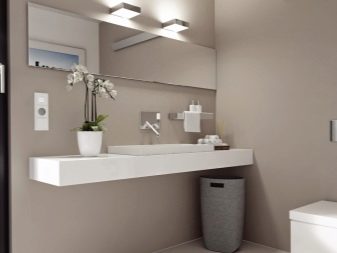
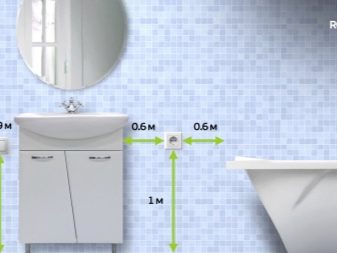
Not everyone knows how best to place switches in the bathroom. It is worth understanding this issue on the basis of two main provisions.
- Avoid getting a lot of moisture on the switch.
- It should be placed as conveniently as possible. The best option: place one switch at the front door to the bathroom, the other directly in the room (preferably at the washbasin or washing machine).
Try to maximize the distance from the shower or bathtub to the switch. A distance of one meter will be normal. However, the main thing in any case is vigilance.
It is better not to use the switch during water procedures, but to adjust all the necessary lighting options using a dimmer or dimmer while still “on the shore”.
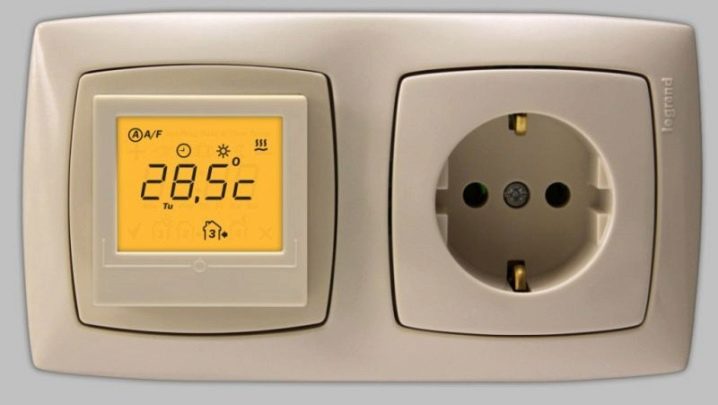
As for the type and design of the switch, this is already a matter of taste. However, several recommendations can be made here as well. Most often, there are classic rectangular switches on sale - when making a purchase, pay attention to the emphasis on pressing the button. It should be clear, without any half-positions.
Another point - do not get carried away by double or triple switches. As a rule, such designs are less reliable than single ones.
In addition, the balance of their use is important. All buttons must be pressed with approximately the same or comparable frequency, otherwise the product will wear out quickly.
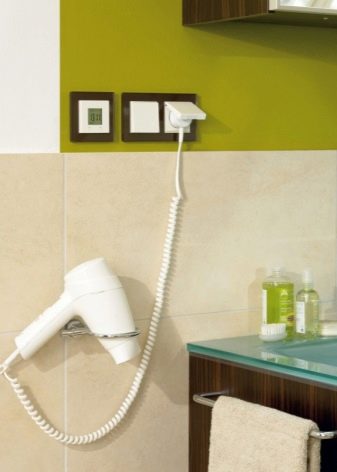
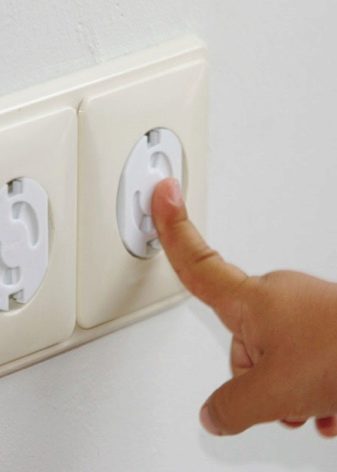
Selection Tips
The market is now well saturated with lighting fixtures. There is a choice of brands from many countries. Each product category has its own characteristics. The choice is a purely individual matter, but in any case it is worth taking into account the national specifics of the products.
We invite you to familiarize yourself with the products of some of the best manufacturing countries.
Italy
Many companies specialize in designer appliances. If there is a desire to purchase an unusual lighting fixture for the bathroom, then it is better to pay attention to Italy. Quality spherical products; lamps consisting of small "soap bubbles"; original point models stylized as pieces of ice or corners of paper curled from moisture.
The main attributes of Italian lamps are brightness and creativity.Italian lamps will perfectly fit into modern interiors: hi-tech, techno and others. At the same time, when using them, the light is often cold. This is an excellent solution for spacious baths, but not always optimal for chamber interior compositions.
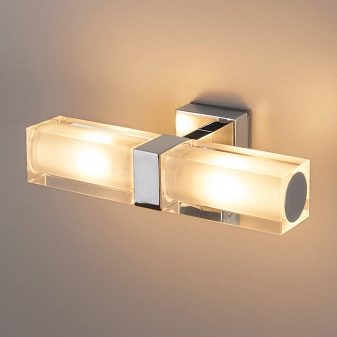
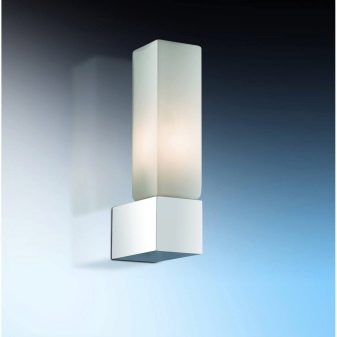
Germany
The traditional qualities of German products are reliability and practicality. The products are minimalist and lack splendor. Such devices are suitable for laconic interiors decorated in a variety of styles.
German manufacturers often focus on the form, which is usually clear and geometrically verified, which gives the room additional balance - and even some rigor. Such lamps will balance a large room and make it more comfortable, in a small room they will simply fit well and will always be in place. Another feature of German goods is also important: their extremely high quality.
The Germans are attentive not only to external details, they are very carefully working on the design of products.
As mentioned above, good moisture resistance is based precisely on the internal structure, including the insulation system.
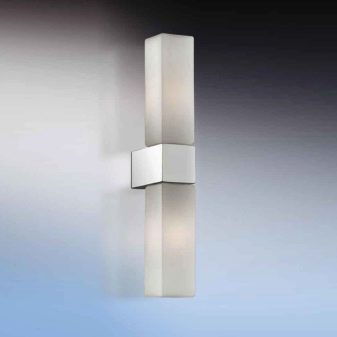
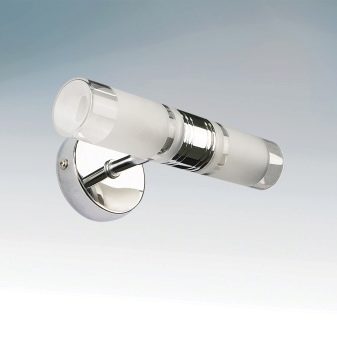
Holland
Often, lamps from a given country are perceived as something stylistically in between Germany and Italy, but this does not always correspond to the truth. The Dutch are really the real masters of the combination of styles - for example, classic and modern, but their products are in many ways unique.
Elegant lamps from this European country are able to bring a touch of sophisticated harmony to the bathroom. At the same time, laconicism is also inherent in Dutch lighting fixtures. Most often on the market there are small models of white and gray shades (with neat smoothed shapes).
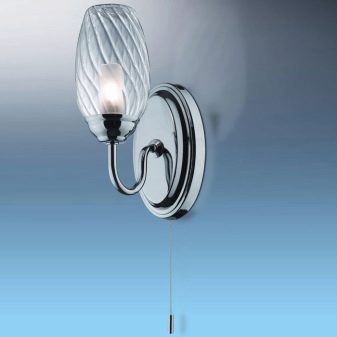

Poland
The most practical, easy-to-use and reliable products. They are often minimalistic, but at the same time they are technologically advanced and affordable. They are worth buying for small to medium sized bathrooms.
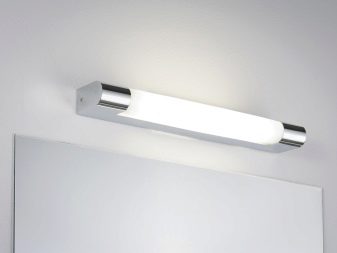
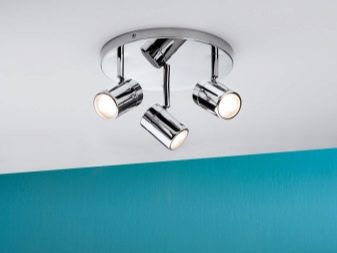
Japan
The country is famous not only for its design unique and easily recognizable floor lamps, but also for other developments. Japan has been home to many high technologies for half a century. It is among the products of this country that interesting solutions for light control are most often found: regulation of lighting, modeling of light space.
If your task is to make the bath not only a place for hygiene and relaxation, but also a space for design experiments, small discoveries, then Japanese lamps will be a suitable option.
In addition, they will provide a feeling of comfort and safety, which is so important for the bathroom. However, only connoisseurs of oriental flavor will be able to feel the last qualities.
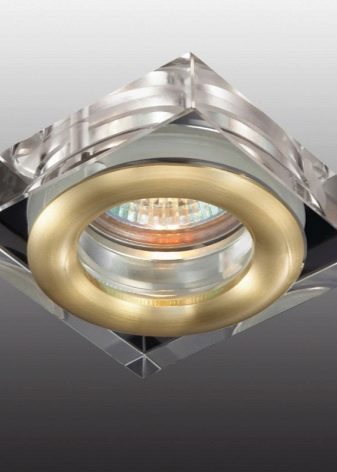
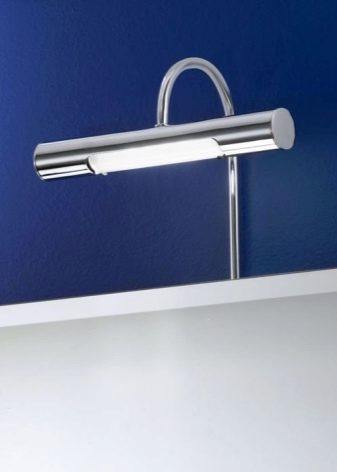
Russia
The lighting market is now actively developing. Many firms specialize in economy class products. The main advantage of such products is that you can always buy the necessary components for them - for example, for repairs.
Nowadays, various design schools are developing in Russia, where the influence of European brands can be traced. But the appearance of original products is also possible. Lighting developments (in particular LED) are actively pursued in the defense industry, and some research results are gradually penetrating the market.
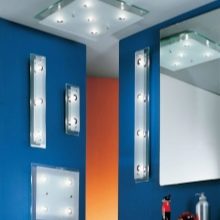
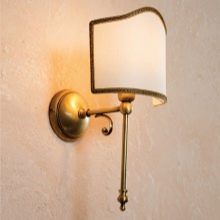

Having decided on the purpose of the luminaire, the place of its installation, the necessary functions and the country of origin, you can already choose a suitable lamp model. The result should be uniform, harmonious lighting in the bathroom (no unplanned dark corners).
It is also important to be able to adjust the lighting and adapt it to yourself, creating (depending on the situation) a cheerful or calm, pleasant romantic atmosphere.
Remember that the bathroom is an extremely intimate place, and the light will greatly influence the kind of emotions you can recharge in it during, for example, a morning or evening shower.
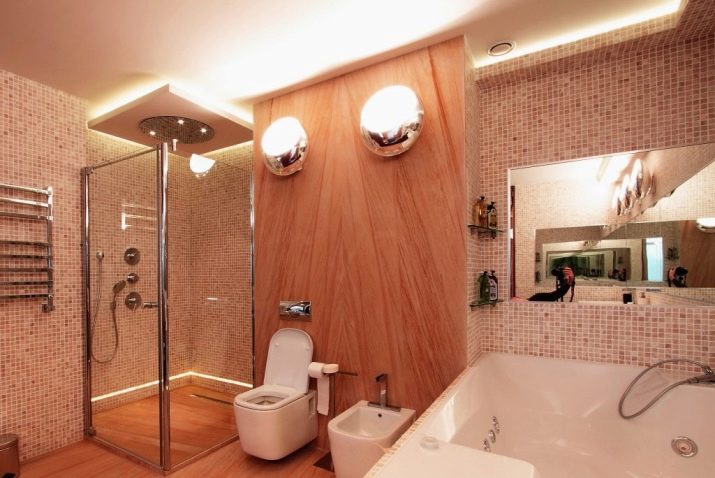
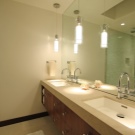

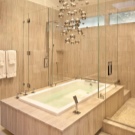
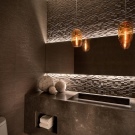
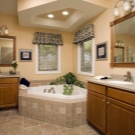
You will learn more about waterproof bathroom fixtures in the following video.













The comment was sent successfully.